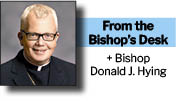
The Feast of the Presentation of the Lord, always celebrated on February 2, marks the 40th day after Christmas, when Mary and Joseph went up to the Temple in Jerusalem to present the infant Jesus to the Lord, as mandated in the Mosaic Law.
In commemoration of the death of the first born in Egypt, the final plague inflicted upon Pharaoh and his people, the Jewish people dedicated their first born son to God, as a form of consecration and thanksgiving.
This feast is also Candlemas Day, when the priest traditionally blesses all of the candles for liturgical use throughout the year, because Simeon called Jesus “the light of the Gentiles.”
We also honor Consecrated Life on this day, those men and women who give themselves to the Lord through a celibate way of love and obedience.
What we can learn
This feast has much to teach us.
A significant aspect of any religion is the practice of sacrifice.
Every ancient culture offered first fruits of the fields, animals, or, sadly, even human beings in the case of the Aztecs, as a sacrifice to the divine, seeking favor and blessings, offering worship and obedience.
The Holy Family offered a pair of turtle doves as their sacrifice at the Presentation, as a symbol of their offering of their Son to God.
In this mystery, we see the unique beauty of Christianity. Even as Mary and Joseph offered Jesus to the Lord, He had come to earth to offer Himself for our salvation.
God Himself becomes the sacrifice on the Cross, the Lord giving up His life so that we could receive the gift of eternal life and forgiveness.
When we realize the enormity of Christ’s love for us, in the momentous gift of His sacrifice, our lives of discipleship become a joyful offering of self to the One who loves us so lavishly.
All of this is foreshadowed in the Presentation.
Simeon, a devout and holy man close to death, received the heavenly promise that he would not die before he had seen the Christ of the Lord.
Moved by the Holy Spirit, he went to the Temple the day of the Holy Family’s visit and took the Holy Infant in his arms and blessed God, calling Jesus “the light of revelation to the Gentiles and the glory for your people, Israel.” (Luke 2: 32)
This Scripture passage does not say that the Christ would come as a baby, which leads me to wonder what Simeon was expecting.
Would the Christ appear as a mighty warrior, a powerful leader, or a great king?
Was the old man surprised when the Lord of Heaven and Earth appeared as a tiny, helpless baby?
Both in His earthly life and now in the realm of the Holy Spirit, the Lord often confounds our expectations of how He will act, where he will appear, and what he will ask of us.
Like Simeon, we too must surrender our preconceptions of who God is or how He is working in our lives, trusting the Holy Spirit to illuminate our understanding and vision with the light of the Lord.
Simeon blessed Joseph and Mary and then uttered this mysterious prophecy to the Blessed Mother, “Behold, this child is destined for the fall and rise of many in Israel, and to be a sign that will be contradicted and you yourself a sword will pierce so that the thoughts of many hearts will be revealed.” (Luke 2: 34-35)
Pointing ahead
This passage both points to the death of the Lord on the Cross and to Mary’s full participation in the mystery of our redemption.
In many artistic depictions of the Deposition from the Cross, visual parallels between the Lord and Mary point out the fullness of the Mother’s sharing in the Passion of her Son.
Both are pallid with their eyes closed.
Jesus is dead; Mary is fainting.
The Lord is coming off of the Cross; Mary is falling into the arms of Saint John.
Without physically dying herself, Mary, nevertheless, gives herself completely in union with the saving sacrifice of Jesus.
As Christians, we know that our suffering has supernatural meaning, when we offer it as a sacrifice of love and unify it to the Lord’s own Passion.
Like Mary, our hearts too are pierced as we watch loved ones suffer illness, addiction, rejection, and death.
Choosing to love will always wound us, but in remaining at the foot of the Cross, standing with the Blessed Virgin, whose maternal heart bled for her Son, we find hope, mercy, and salvation.
The Sorrowful Mother is the paramount icon of compassion, this profound suffering with her Son for the sake of the salvation of the world.
Through her, we learn that we cannot love from the safety of distance, that to serve the Lord, is to be willing to enter the dark night of sorrow which afflicts so many hearts, and to bring the light and hope of Christ, crucified, but also risen and victorious, to assuage the sufferings of our brothers and sisters.
Christ’s path of vulnerability and His embrace of the sacrifice of the Cross, Mary’s maternal sufferings, symbolized by her pierced heart, the gift of Heavenly light given to us in the Gospel, and the treasure of Consecrated Life in the Church all shine with a particular radiance on this Feast of the Presentation.

